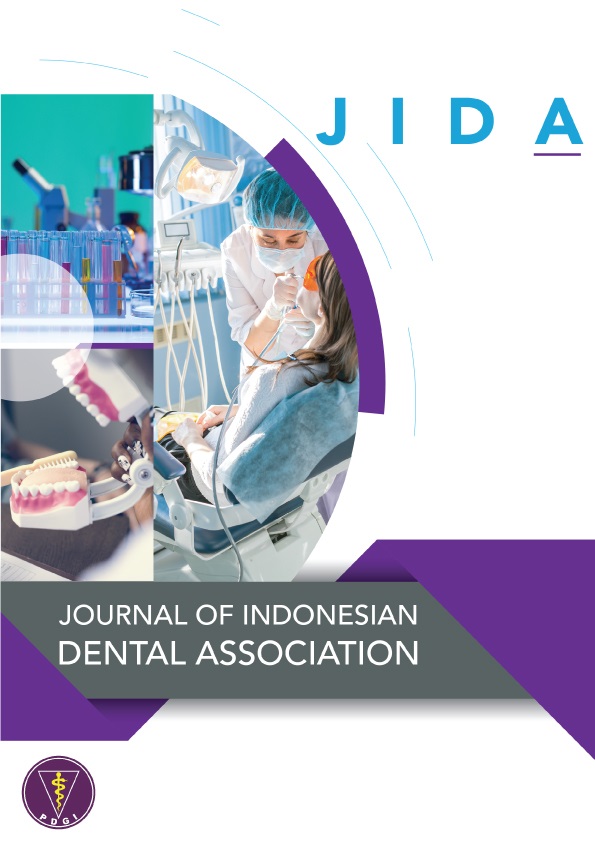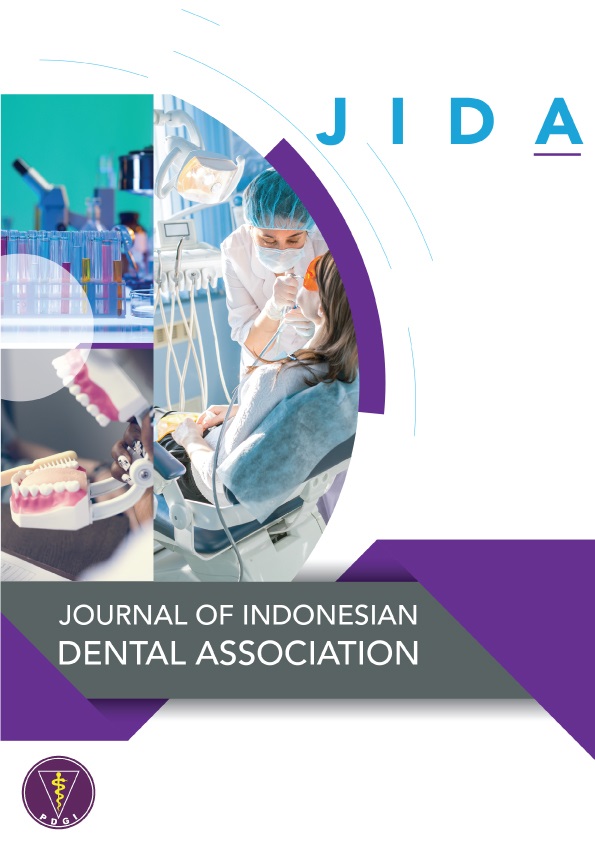Root Canal Irrigation NaOCl 2,5% plus Nano Chitosan as an Antibacterial Pseudomonas Aeruginosa
Abstract
Chitosan tilapia scales is one of the chitosans which has benefits as an antibacterial in dental root canal, the physical size of chitosan can be converted into smaller particle sizes in the form of nanoparticles. For the material of root canal irrigation as a gold standard is sodium hypochlorite 0.5% -5.25%. One of the bacteria found in the root canal is Pseudomonas aeruginosa. The purpose of this study was to determine the effectiveness of nano chitosan tilapia scales plus 1.5% and 2.5% NaOCl in inhibiting Pseudomonas aeruginosa. This research is a laboratory experimental study with the research design used is the Post Test Only Control Group Design antibacterial test Kirby Bauer. The sample used was the bacterium Pseudomonas aeruginosa which was divided into 4 groups: group 1 was the treatment group given nano chitosan of tilapia scales plus 1.5% NaOCl, group 2 was the treatment group given nano chitosan of tilapia scales plus 2.5% NaOCl, group 3 of the treatment group was given a positive control with Chlorhexidine and group 4 of the treatment group was given a negative control of aquadest with 6 repetitions for each. The results of statistical tests using the Least Significant Difference (LSD) test showed that there were significant differences in the inhibition zone between nano chitosan of tilapia scale plus 1.5% and 2.5% NaOCl with a value of r <0.05. The average inhibition power of nano chitosan of tilapia scales plus 1.5% NaOCl was 21.33 mm and nano chitosan of tilapia scales plus 2.5% NaOCl was 24.83. It can be concluded that nano chitosan of tilapia scale plus 1.5% NaOCl and nano chitosan of tilapia scale plus 2.5% NaOCl have very strong inhibition against Pseudomonas aeruginosa. Nano chitosan of tilapia scales plus 2.5% NaOCl is more effective in inhibiting Pseudomonas aeruginosa.Keywords: Root canal irrigation NaOCl 2.5%, Nano Chitosan, Antibacterial
References
1. Health Development Policy Agency. Indonesian Health Survey (SKI). Ministry of Health Republic of Indonesia. Jakarta. 2023
2. Rusmawaty VA, Sugito BH, Edi IS. Level of Knowledge About Dental Health with Dental Caries. International Journal of Advanced Health Science and Technology. 2024; 4(4):157-61. https://doi.org/10.35882/ijahst.v4i4.393
3. Kartinawanti AT, Asy'ari AK. Pulp disease and root canal treatment in one visit. Jurnal Ilmu Kedokteran Gigi. 2021; 4(2): 64–72
4. Grossman LI, Oliet S, Del Rio CE. Endodontics in Practice. Edisi 11. EGC. Jakarta.1995.p.68
5. Hulsmann M, Hahn W. Complications during root canal irrigation–literature review and case reports. International endodontic journal. 2020;33(3):186-93
6. Azhar M, Efendi J, Sofyeni E, Lesi RF, Novalina S. The effect of NaOH and KOH concentration on the degree of deacetylation of chitin from shrimp shell waste. Eksakta. 2010;1(11):1–8
7. Sivakami MS, Gomathi T, Venkatesan J, Jeong HS, Kim SK, Sudha PN. Preparation and characterization of nano chitosan for treatment wastewaters. Int J Biol Macromol. 2013; 57:204-12. doi: 10.1016/j.ijbiomac.2013.03.005.
8. Chávez de Paz LE, Resin A, Howard KA, Sutherland DS, Wejse PL. Antimicrobial effect of chitosan nanoparticles on streptococcus mutans biofilms. Appl Environ Microbiol. 2011;77(11):3892-95.doi:10.1128/AEM.02941-10
9. No HK, Lee SH, Park NY, Meyers SP. Comparison of physicochemical, binding, and antibacterial properties of chitosans prepared without and with deproteinization process. J Agric Food Chem. 2003 Dec 17;51(26):7659-63. doi: 10.1021/jf030226w.
10. Magani AK, Tallei TE, Kolondam BJ. Antibacterial test of chitosan nanoparticles on the growth of Staphylococcus aureus and Escherichia coli bacteria. Jurnal Bios Logos. 2020;10(1):7-12
11. Silalahi AM, Fadholah A, Artanti LO. Isolasi dan identifikasi kitin dan kitosan dari cangkang susuh kura (Sulcospira testudinaria). Pharmaceutical Journal of Islamic Pharmacy. 2020;4(1):1-9
12. Agrawal A, Reche A, Agrawal S, et al. Applications of Chitosan Nanoparticles in Dentistry: A Review. Cureus. 2023;5(12): e49934. Doi 10.7759/cureus.49934
13. Deviyanti S. The potential of 0,2% chitosan solution as an alternative irrigation material in root canal treatment. Jurnal Ilmiah dan Teknologi Kedokteran Gigi. 2018;14(1):6–10
14. Ratih DN, Sari NI, Santosa P, Kaswati NMN. Time-Dependent Effect of Chitosan Nanoparticles as Final Irrigation on the Apical Sealing Ability and Push-Out Bond Strength of Root Canal Obturation. Int J Dent. 2020; 15:8887593. Doi: 10.1155/2020/8887593.
15. Abubaker Qutieshat, Nutayla Al Harthy, Shima Al Busaidi, Ahmed Al Sadoon, Dima Al Sayahien, Maryam Sedqi, Sumaiya Al Rashdi, Samiya Al Ghammari. Antimicrobial Irrigation Solutions in Root Canal Treatment: A Glance at the Past, the Present, and the Future. The Open Dentistry Journal. 2023;17: E18742106.
Doi: 10.2174/18742106-v17-230621-2023-5.
16. Orozco-Gallego MJ, Pineda-Vélez EL, Rojas-Gutiérrez WJ, Rincón-Rodríguez ML, Agudelo-Suárez AA. Effectiveness of Irrigation Protocols in Endodontic Therapy: An Umbrella Review. Dent J (Basel). 2025;13(6):273.
doi: 10.3390/dj13060273.
2. Rusmawaty VA, Sugito BH, Edi IS. Level of Knowledge About Dental Health with Dental Caries. International Journal of Advanced Health Science and Technology. 2024; 4(4):157-61. https://doi.org/10.35882/ijahst.v4i4.393
3. Kartinawanti AT, Asy'ari AK. Pulp disease and root canal treatment in one visit. Jurnal Ilmu Kedokteran Gigi. 2021; 4(2): 64–72
4. Grossman LI, Oliet S, Del Rio CE. Endodontics in Practice. Edisi 11. EGC. Jakarta.1995.p.68
5. Hulsmann M, Hahn W. Complications during root canal irrigation–literature review and case reports. International endodontic journal. 2020;33(3):186-93
6. Azhar M, Efendi J, Sofyeni E, Lesi RF, Novalina S. The effect of NaOH and KOH concentration on the degree of deacetylation of chitin from shrimp shell waste. Eksakta. 2010;1(11):1–8
7. Sivakami MS, Gomathi T, Venkatesan J, Jeong HS, Kim SK, Sudha PN. Preparation and characterization of nano chitosan for treatment wastewaters. Int J Biol Macromol. 2013; 57:204-12. doi: 10.1016/j.ijbiomac.2013.03.005.
8. Chávez de Paz LE, Resin A, Howard KA, Sutherland DS, Wejse PL. Antimicrobial effect of chitosan nanoparticles on streptococcus mutans biofilms. Appl Environ Microbiol. 2011;77(11):3892-95.doi:10.1128/AEM.02941-10
9. No HK, Lee SH, Park NY, Meyers SP. Comparison of physicochemical, binding, and antibacterial properties of chitosans prepared without and with deproteinization process. J Agric Food Chem. 2003 Dec 17;51(26):7659-63. doi: 10.1021/jf030226w.
10. Magani AK, Tallei TE, Kolondam BJ. Antibacterial test of chitosan nanoparticles on the growth of Staphylococcus aureus and Escherichia coli bacteria. Jurnal Bios Logos. 2020;10(1):7-12
11. Silalahi AM, Fadholah A, Artanti LO. Isolasi dan identifikasi kitin dan kitosan dari cangkang susuh kura (Sulcospira testudinaria). Pharmaceutical Journal of Islamic Pharmacy. 2020;4(1):1-9
12. Agrawal A, Reche A, Agrawal S, et al. Applications of Chitosan Nanoparticles in Dentistry: A Review. Cureus. 2023;5(12): e49934. Doi 10.7759/cureus.49934
13. Deviyanti S. The potential of 0,2% chitosan solution as an alternative irrigation material in root canal treatment. Jurnal Ilmiah dan Teknologi Kedokteran Gigi. 2018;14(1):6–10
14. Ratih DN, Sari NI, Santosa P, Kaswati NMN. Time-Dependent Effect of Chitosan Nanoparticles as Final Irrigation on the Apical Sealing Ability and Push-Out Bond Strength of Root Canal Obturation. Int J Dent. 2020; 15:8887593. Doi: 10.1155/2020/8887593.
15. Abubaker Qutieshat, Nutayla Al Harthy, Shima Al Busaidi, Ahmed Al Sadoon, Dima Al Sayahien, Maryam Sedqi, Sumaiya Al Rashdi, Samiya Al Ghammari. Antimicrobial Irrigation Solutions in Root Canal Treatment: A Glance at the Past, the Present, and the Future. The Open Dentistry Journal. 2023;17: E18742106.
Doi: 10.2174/18742106-v17-230621-2023-5.
16. Orozco-Gallego MJ, Pineda-Vélez EL, Rojas-Gutiérrez WJ, Rincón-Rodríguez ML, Agudelo-Suárez AA. Effectiveness of Irrigation Protocols in Endodontic Therapy: An Umbrella Review. Dent J (Basel). 2025;13(6):273.
doi: 10.3390/dj13060273.
Published
2025-10-26
How to Cite
WEDAGAMA, Dewa Made.
Root Canal Irrigation NaOCl 2,5% plus Nano Chitosan as an Antibacterial Pseudomonas Aeruginosa.
Journal of Indonesian Dental Association, [S.l.], v. 8, n. 2, p. 66-70, oct. 2025.
ISSN 2621-6175.
Available at: <http://jurnal.pdgi.or.id/index.php/jida/article/view/1441>. Date accessed: 15 nov. 2025.
Section
Research Article

This work is licensed under a Creative Commons Attribution-NonCommercial 4.0 International License.












